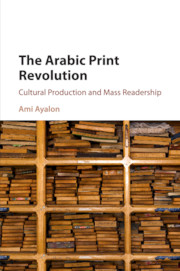Book contents
- Frontmatter
- Dedication
- Contents
- Preface and Acknowledgments
- Introduction
- 1 The Formative Phase of Arab Printing: A Historical Overview
- 2 Printers and Publishers
- 3 Books, Journals, Cartes de visite
- 4 Diffusion Channels
- 5 Advancing Circulation
- 6 Reading and Readers
- 7 Reading in Public
- Conclusion
- Bibliography
- Index
1 - The Formative Phase of Arab Printing: A Historical Overview
Published online by Cambridge University Press: 05 September 2016
- Frontmatter
- Dedication
- Contents
- Preface and Acknowledgments
- Introduction
- 1 The Formative Phase of Arab Printing: A Historical Overview
- 2 Printers and Publishers
- 3 Books, Journals, Cartes de visite
- 4 Diffusion Channels
- 5 Advancing Circulation
- 6 Reading and Readers
- 7 Reading in Public
- Conclusion
- Bibliography
- Index
Summary
As the eighteenth century turned into the nineteenth, the Ottoman and Arab benign disregard for printing began to crack and give way to a different attitude. The new century would witness a gradual and eventually extensive Arab adoption of printing, the birth of a publishing industry, and the emergence of massive reading in Arab societies, changes that would further accelerate in the following century.
These developments were central pillars in the historic movement known as the Arab nahḍa, a term that will appear repeatedly in this and later chapters. Before proceeding further, it would be worthwhile to take a brief look at this notion and its relation to our subject. “The Arab nahḍa” is a loose construct with a range of meanings. Used flatly with no additional specification, it is taken as a name for the vigorous “awakening,” or “revival,” of intellectual and literary activity that took place in certain Ottoman–Arab provinces during the latter decades of Ottoman rule. Among its prominent marks were an increase in literary and linguistic creativity and an excited journalistic enterprise. Opening up new intellectual vistas, this enterprise engaged members of the society's educated classes in a vivid written discourse on questions of modernity and cultural identity and encouraged the spread of learning and literacy. “Nahḍa” is also used in a different, essentially political sense to denote the vocal quest for national liberation, political rights, and individual freedom that ensued, or rather emanated from, the cultural ferment of that period. There is no clear division between the cultural and the political; usually they are closely intertwined. Even when considering themes that appear to be purely cultural, political implications are always there. Such, for instance, are questions concerning the role of foreign (as distinct from local) actors in generating the changes, or the share of non-Muslim minority members (vs. that of Muslims) in advancing them, which are essential to the cultural exploration but also bear obvious political allusions. The same is true when the nahḍa's historic time framework, especially its inception, is considered: Did it start at the beginning of the nineteenth century, or even earlier (and hence was the fruit of a local-inner endeavor), or after mid-century (and hence was largely a product of foreign initiatives)?
- Type
- Chapter
- Information
- The Arabic Print RevolutionCultural Production and Mass Readership, pp. 18 - 32Publisher: Cambridge University PressPrint publication year: 2016

